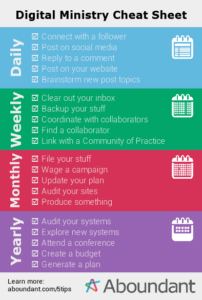Make these digital ministry tasks a habit
New habits change things, whether that habit has to do with an exercise regime, a business goal, or your ministry. “Digital ministry” is a brief phrase that encapsulates all of the tech-related tasks that help you to reach out beyond your organization, connect with people, communicate effectively, and keep all of your systems running smoothly.
Here are 5 daily, weekly, monthly and annual tasks we recommend become habitual for you. Implementing these in your life and work will at first take some time, but soon you’ll find they become second nature and a valuable part of your day.
 Download and print this handy “cheat sheet.” Keep a copy taped to your monitor or posted where you’ll see it regularly. If you use an app to keep track of your daily tasks, enter these items in as repeating events. Here’s a bit more explanation for each item on the Cheet Sheet.
Download and print this handy “cheat sheet.” Keep a copy taped to your monitor or posted where you’ll see it regularly. If you use an app to keep track of your daily tasks, enter these items in as repeating events. Here’s a bit more explanation for each item on the Cheet Sheet.
5 Daily Tasks
1. Connect with a follower
The actual, real lives of the members and friends of your church or faith organization are important to them and are where they live out their faith. Show you know that by posting on their facebook page when you see an important post or notice they have a birthday. Respond to a Tweet you like. Dash off a quick text to someone you haven’t seen in a while. These little connections are not at all insignificant; they show you are just as interested in their lives as they are in the ministry of your organization.
2. Post on social media
A daily post keeps your organization front and center in people’s minds, and the things you post from on your faith group’s page do not just have to be announcements. Share a story about something meaningful that happened in a class. Link to an article you found particularly interesting. Highlight events that are happening in your neighborhood. And yes, do remind your followers of things like new sermon series, schedule changes, volunteer opportunities, and other announcements.
3. Reply to a comment
Don’t wait for days to respond to comments to the posts on your Facebook page or website. The same is true for approving comments, if you don’t allow them to be immediately visible. Quick responses show readers that you are interested in dialogue and pay attention to what is being said about your ministries.
4. Post on your website
Fresh content isn’t just good for your existing members, but it also improves your likelihood that someone new will stumble across your website. So, get in the habit of creating a new post, updating a page, tweaking a volunteer need, uploading a sermon MP3, or sharing a photo on a daily basis.
5. Brainstorm new post topics
Keep a list handy (I heartily recommend Evernote) with ideas for future posts, tagged with ministry categories and months they would be appropriate. By adding to your list regularly, you’ll discover that ideas will spark new ideas, and you won’t run dry.
5 Weekly Tasks
1. Clear out your inbox
There are many systems for staying on track of your to-do list, but often overlooked is making sure you don’t let things pile up unread or unfinished in your inbox. Schedule a time at the beginning and/or end of your week to review, file, delete, and respond to whatever messages you just couldn’t get to during the week.
2. Backup your stuff
Crashes (and hacks) happen. Recovering from them is frustrating, time-consuming, and inconvenient. Good backups of your website, computer, server, and external drives should be made at least weekly.
3. Coordinate with collaborators
Do you have a time in your weekly staff meetings to plan and collaborate on your social media posts? This is a great thing to do as you review your upcoming calendar together.
4. Find a collaborator
Ministry is meant to be shared. Empower your organization’s members by training and equipping your congregation to be part of your social media, website, and graphic design teams. The way to begin is to notice who writes well, posts great photos, or seems especially adept at connecting with friends via social media. Then, reach out and initiate a conversation about how they could be in ministry with you.
5. Link with a Community of Practice
Your Community of Practice (or Tribe, as some call it) is your community where you learn from and share with others about the “doing” of ministry, whether that be middle school youth ministry, jazz-based worship services, or parents who love children’s literature. Be sure to contribute to your Community of Practice on at least a weekly basis–for your own growth and so others can benefit from your knowledge.
5 Monthly Tasks
1. File your stuff
Are your photos just in one giant, uncategorized folder? Do unused files litter your desktop? If either of these are true, it’s time to start using a better digital filing system. Categorize your photos and other media in folders, then tag them with even more information, such as team or individual names. File your documents away frequently in a way that doesn’t just make sense to you but would be understandable to someone who has to use your computer or files later.
2. Wage a campaign
“Campaign” is shorthand for public media that tells a story about your organization or an event. Ideally, you should upload a video to social media (e.g. YouTube or Vimeo) that links back to your website at least once per month. That video doesn’t need to be highly produced; even simple, short videos can be extremely effective, such as Facebook Live videos. Work with a team of collaborators to make sure that happens, then embed the video into your website and blast it through all of your communication channels.
3. Update your plan
Review your 6-month and 1-year marketing plans, revising as necessary. By staying on top of your marketing plan, you won’t suddenly be stuck in a situation where it’s too late, for example, to order banners or promotional giveaways for an event. Plus, it helps you to make sure your budget is still on track.
4. Audit your sites
Any pages with general information, such as worship times or small group schedules, should be reviewed at least monthly to make sure the details like dates, contact persons, and locations are correct. Don’t wait until a day or two before a schedule change, such as moving from two worship services to one in the summertime; note the coming changes a month ahead, and make the final changes as soon as the current schedule is obsolete.
5. Produce something
What could you create that would inform a complete newcomer about your organization? What might existing members not know about as fully as they could? Videos, brochures, booklets, catalogs, ebooks, special newsletters, magazines, 3x3s, and more can be highly effective, multi-purpose tools for promoting your regular and special events. Use your creative energy and dream up some big ideas!
5 Yearly Tasks
1. Audit your systems
Each year, give a thorough review to all of your systems: production, distribution, backup, communication, follow-up, evaluation, and so on. Look for opportunities to streamline processes, to eliminate waste, to stop methods that produce few results, and to update old technologies.
2. Explore new systems
When was the last time you read a book on a tech-related topic? Even if technology isn’t your primary strength, it is a great idea to keep in touch with the latest approaches to digital marketing, the basics of graphic design, and the ways to better utilize social media.
3. Attend a conference
Most staff people in religious organizations attend a conference or worship during a typical year, but often those events tend to be highly job-specific. For example, children’s ministry staff attend events that focus on educational techniques and curriculum. Those events are terrific and highly useful, but try also to attend workshops and conferences on topics that fall outside your specialization. Take courses (including elearning courses, such as Udemy) or go to conferences that will expand your technical/digital skill set.
4, Create a budget
Are your existing budgets created with digital marketing and technology in mind? If not, be sure to pay attention to additional costs you might incur in the next year, such as stock photos and graphics, web-based tools, website upgrades, or outsourced work.
5. Generate a plan
You can’t do everything, and that’s the simple reason why you need a master plan which can serve as a filter and guide your daily work. By prioritizing and always trying to work on projects about nine months in advance, you’ll find you have greater clarity about what you need to be doing, how long it will take, and what kind of help you need to recruit from your members or hired freelancers.
Good digital ministry has much to do with creating sustainable daily, weekly, monthly and annual habits. Why not give these a try for the next several weeks to see how your own ministry benefits?
